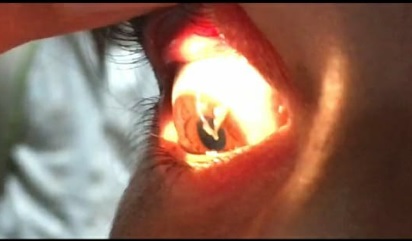Wriggly creatures coming out of eye: case report on human ocular thelaziasis
Abstract
Ocular Thelaziasis is an arthropod-borne, zoonotic disease of the eye affecting the conjunctival sac, lacrimal duct, and lacrimal gland caused by a nematode of the genus Thelazia. Thelazia species are transmitted by different species of Muscidae, which are a family of flies with worldwide distribution. The present study reports a case of human ocular Thelaziasis in a 13-year-old female patient. Species Thelazia callipaeda was confirmed based on microbiological examination. The patient was treated with anti-helminthic drugs and was relieved of the symptoms without recurrence.
Downloads
References
Otranto D, Dutto M. Human thelaziasis, Europe. Emerg Infect Dis. 2008;14(4):647-649. doi: 10.3201/eid1404.071205.
Viriyavejakul P, Krudsood S, Monkhonmu S, Punsawad C, Riganti M, Radomyos P. Thelazia callipaeda: a human case report. Southeast Asian J Trop Med Public Health. 2012;43(4):851-856.
Mihalca AD, D’Amico G, Scurtu I, Chirilă R, Matei IA, Ionică AM. Further spreading of canine oriental eyeworm in Europe: first report of Thelazia callipaeda in Romania. Parasite Vectors. 2015;8(1):48. doi: 10.1186/s13071-015-0663-2.
Otranto D, Traversa D. Thelazia eyeworm: an original endo- and ecto-parasitic nematode. Trends Parasitol. 2005;21 (1):1-4. doi: 10.1016/j.pt.2004.10.008.
De NV, Le TH, Chai JY. The first human case of Thelazia callipaeda infection in Vietnam. Korean J Parasitol. 2012;50(3):221-223. doi: 10.3347/kjp.2012.50.3.221.
Otranto D, Lia RP, Buono V, Traversa D, Giangaspero A. Biology of Thelazia callipaeda (Spirurida, Thelaziidae) eyeworms in naturally infected definitive hosts. Parasitol. 2004;129(5):627. doi: 10.1017/s0031182004006018.
Vieira L, Rodrigues FT, Costa Á, Diz-Lopes D, Machado J, Coutinho T, et al. First report of canine ocular thelaziosis by Thelazia callipaeda in Portugal. Parasit Vectors 2012;5 (1):124. doi: 10.1186/1756-3305-5-124.
Naem S. Thelazia species and conjunctivitis. In: Pelikan, Z, editors. , ed. Conjuctivitis—A Complex and Multifaceted Disorder. Croatia, Europe: INTECH open science/open minds; 2011:201–32, chapter 13.
Yang YJ, Liag TH, Lin SH, Chen HC, Lai SC. Human thelaziasis occurrence in Taiwan. Clin Exp Optom 2006;89(1):40-44. doi: 10.1111/j.1444-0938.2006.00008.x.
Bradbury RS, Breen KV, Bonura EM, Hoyt JW, Bishop HS. Case report: Conjunctival infestation with Thelazia gulosa: a novel agent of human thelaziasis in the United States. Am J Trop Med Hyg. 2018; 98(4):1171–1174. doi: 10.4269/ajtmh.17-0870.

Copyright (c) 2021 Author (s). Published by Siddharth Health Research and Social Welfare Society

This work is licensed under a Creative Commons Attribution 4.0 International License.


 OAI - Open Archives Initiative
OAI - Open Archives Initiative



















 Therapoid
Therapoid

